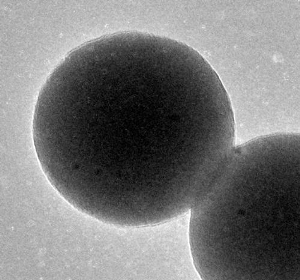Jul 14 2010
The research program of Natcore Technology Inc. (TSX-V: NXT; Pink Sheets: NTCXF) being conducted at Rice University under the direction of Prof. Andrew Barron has successfully encapsulated silicon quantum dots with a uniform coating of silicon dioxide.
This represents a crucial milestone in Natcore's development of an all-silicon, super-efficient tandem solar cell. To the knowledge of Natcore scientists, such an encapsulization of individual silicon nanocrystals, or quantum dots (QDs), in silicon dioxide has never before been accomplished.
 Silicon quantum dot encapsulated in silicon dioxide.
Silicon quantum dot encapsulated in silicon dioxide.
The silicon dioxide coating was achieved using Rice University's patented liquid phase deposition (LPD) process, to which Natcore has the exclusive worldwide license. As a result of this unprecedented accomplishment, Natcore can now work toward the construction of multiple layers of silicon QDs in orderly, three dimensional arrays that could more efficiently absorb shorter wavelength light (i.e., higher-energy photons) than is possible in ordinary bulk silicon.
When added to the top of a standard silicon solar cell, such stacked arrays could significantly increase the efficiency of the silicon solar cell at a much lower cost per additional watt than that of the original cell itself. Theoretical calculations by various independent research groups and published in the open literature show that efficiency of over 30% for tandem solar cells in terrestrial sunlight is possible.
Efficiency of greater than 30% would represent approximately double the power output of today's commercial silicon solar cells, and would likely bridge the economic gap between solar and conventional power generation.
Tandem solar cells are a proven technology currently employed in space applications. The major issue preventing their broad use in earth-based applications has been the need to use exotic semiconducting materials for the upper layers, and the expensive special vacuum processing technology that limits large-scale production.
In contrast, Natcore's LPD technology eliminates the need for such materials and their costly processing, and promises to usher in a period of unprecedented growth in the application of solar cells for electrical power generation.
Chuck Provini, Natcore's president and CEO, notes "This is a huge step toward a super-efficient solar cell. By encapsulating QDs in silicon dioxide, we hope to be able to stack them, much like ping-pong balls in a box. The resulting array promises to make a silicon tandem cell possible. We're now working aggressively toward that goal."
Natcore's chairman, Brien Lundin, says "This breakthrough is testimony to the abilities of Prof. Barron and his team, as well as the versatility of our LPD process. These fundamental achievements could revolutionize solar technology and many other applications and industries as well."
Source: http://www.NatcoreSolar.com/